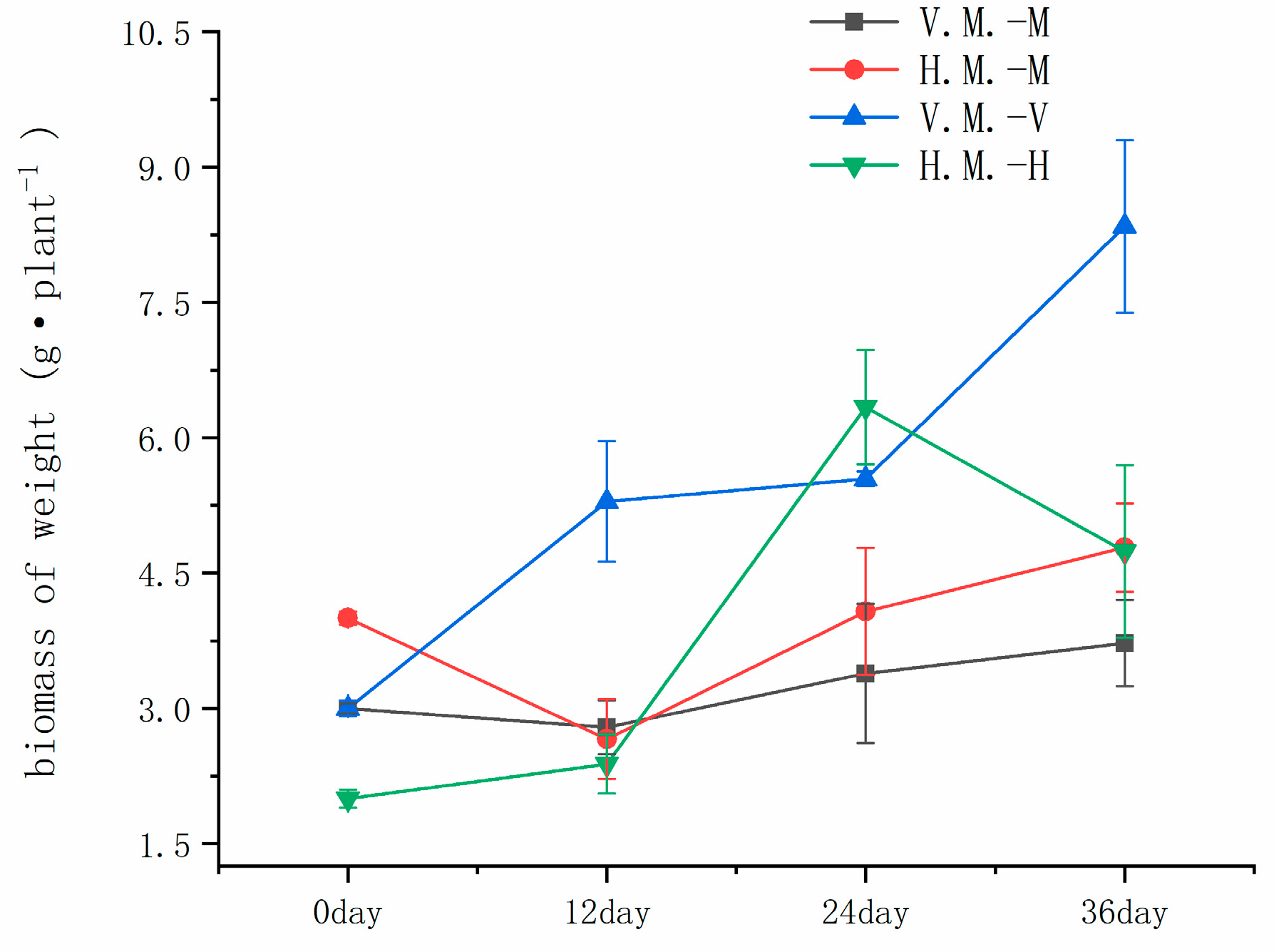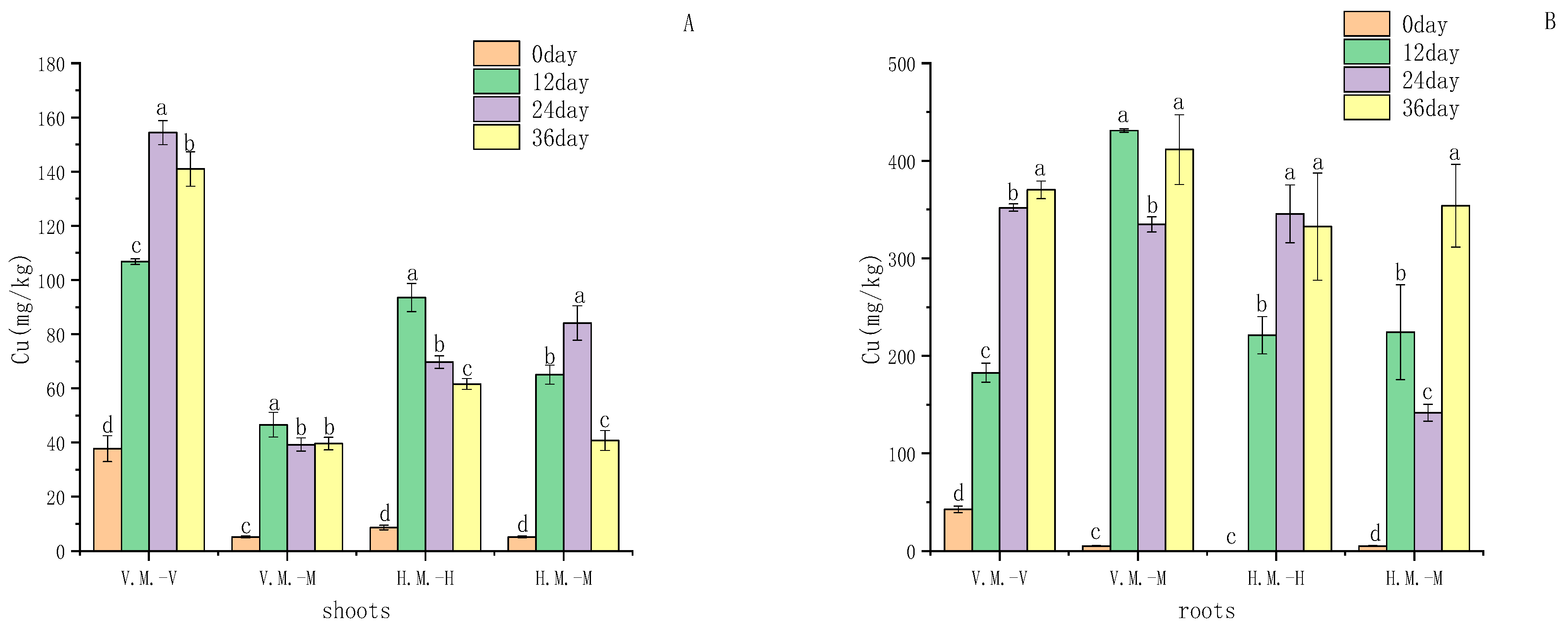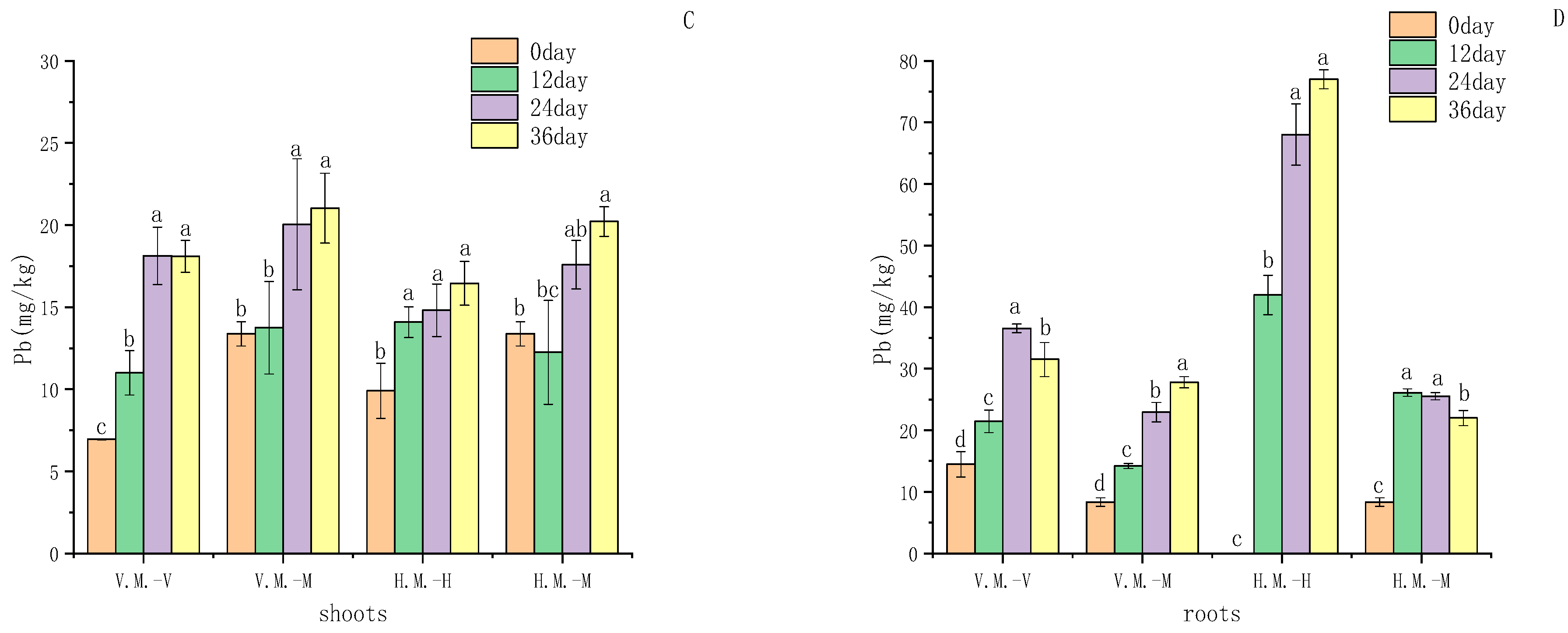Phytoremediation Competence of Composite Heavy-Metal-Contaminated Sediments by Intercropping Myriophyllum spicatum L. with Two Species of Plants
Abstract
:1. Introduction
2. Materials and Methods
2.1. Source, Collection, and Processing of Samples
2.2. Planting and Sampling
2.3. Sediment and Plant Metal Determination
2.3.1. Plant Metal Determination
2.3.2. Sediment Metal Determination
2.4. The Growth Rate
2.5. TF, BCF and BF
2.6. Risk Assessment of Heavy Metals in Sediments
2.7. Statistical Analysis
3. Results and Discussion
3.1. Plant Growth
3.2. Plant Heavy Metal Enrichment
3.3. Heavy Metal Transport in Submerged Plants
3.4. Heavy Metal Content and Risk Assessment in Sediments
4. Conclusions
Author Contributions
Funding
Institutional Review Board Statement
Informed Consent Statement
Data Availability Statement
Conflicts of Interest
References
- Lu, X.; Pan, H.; Wang, Y. Pollution evaluation and source analysis of heavy metal in roadway dust from a resource-typed industrial city in Northwest China. Atmos. Pollut. Res. 2017, 8, 587–595. [Google Scholar] [CrossRef]
- Zalasiewicz, J.; Williams, M.; Steffen, W.; Crutzen, P. The new world of the anthropocene. Environ. Sci. Technol. 2010, 44, 2228–2231. [Google Scholar] [CrossRef] [PubMed]
- García Martín, J.F.; Carrión Ruiz, J.; Torres García, M.; Feng, C.-H.; Mateos, P. Esterification of free fatty acids with glycerol within the biodiesel production framework. Processes 2019, 7, 832. [Google Scholar] [CrossRef]
- Hu, B.; Guo, P.; Su, H.; Deng, J.; Zheng, M.; Wang, J.; Wu, Y.; Jin, Y. Fraction distribution and bioavailability of soil heavy metals under different planting patterns in mangrove restoration wetlands in Jinjiang, Fujian, China. Ecol. Eng. 2021, 166, 106242. [Google Scholar] [CrossRef]
- Gill, L.W.; Ring, P.; Casey, B.; Higgins, N.M.; Johnston, P.M. Long term heavy metal removal by a constructed wetland treating rainfall runoff from a motorway. Sci. Total Environ. 2017, 601–602, 32–44. [Google Scholar] [CrossRef] [PubMed]
- Zou, T.; Li, T.; Zhang, X.; Yu, H.; Luo, H. Lead accumulation and tolerance characteristics of Athyrium wardii (Hook.) as a potential phytostabilizer. J. Hazard. Mater. 2011, 186, 683–689. [Google Scholar] [CrossRef]
- Sen, S. Macrophytes in phytoremediation of heavy metals in aquatic ecosystems: An overview. J. Environ. Sociobiol. 2015, 12, 25–26. [Google Scholar]
- Shrivastava, M.; Srivastava, S. Application and research progress of Hydrilla verticillata in ecological restoration of water contaminated with metals and metalloids. Environ. Chall. 2021, 4, 100177. [Google Scholar] [CrossRef]
- Yan, X.; Yu, D.; Wang, H.; Wang, J. Response of submerged plant (Vallisneria spinulosa) clones to lead stress in the heterogenous soil. Chemosphere 2006, 63, 1459–1465. [Google Scholar] [CrossRef]
- Qian, Y.; Cheng, C.; Drouillard, K.; Zhu, Q.; Feng, H.; He, S.; Fang, Y.; Qiao, S.; Kolenčíka, M.; Chang, X. Bioaccumulation and growth characteristics of Vallisneria natans (Lour.) Hara after chronic exposure to metal-contaminated sediments. Environ. Sci. Pollut. Res. 2019, 26, 20510–20519. [Google Scholar] [CrossRef]
- Wang, S.; Wei, S.; Ji, D.; Bai, J. Co-planting Cd contaminated field using hyperaccumulator Solanum Nigrum L. through interplant with low accumulation welsh onion. Int. J. Phytoremedt. 2015, 17, 879–884. [Google Scholar] [CrossRef] [PubMed]
- Yi, T.; Juan, H.E.; Xuena, Y.U.; Yongdong, X.I.; Lijin, L.I.; Guochao, S.U.; Huanxiu, L.I.; Mingan, L.I.; Liang, D.; Hui, X.I.; et al. Intercropping with Solanum nigrum and Solanum photeinocarpum from two ecoclimatic regions promotes growth and reduces cadmium uptake of eggplant seedlings. Pedosphere 2017, 27, 638–644. [Google Scholar]
- Patil, S.M.; Chandanshive, V.V.; Rane, N.R.; Khandare, R.; Watharkar, A.D.; Govindwar, S.P. Bioreactor with Ipomoea hederifolia adventitious roots and its endophyte Cladosporium cladosporioides for textile dye degradation. Environ. Res. 2016, 146, 340–349. [Google Scholar] [CrossRef]
- Tatár, E.; Mihucz, V.G.; Varga, A.; Záray, G.; Fodor, F. Determination of organic acids in xylem sap of cucumber: Effect of Lead contamination. Microchem. J. 1998, 58, 306–314. [Google Scholar] [CrossRef]
- Yang, Y.Y.; Jung, J.Y.; Song, W.Y.; Suh, H.S.; Lee, Y. Identification of rice varieties with high tolerance or sensitivity to lead and characterization of the mechanism of tolerance. Plant Physiol. 2000, 124, 1019–1026. [Google Scholar] [CrossRef]
- Gong, X.F.; Chen, C.L.; Zhou, W.B.; Jian, M.F.; Zhang, Z.H. Assessment on heavy metal pollution in the sediment of Poyang Lake. Environ. Sci. 2006, 27, 732–736. [Google Scholar]
- Xue, P.; Li, G.; Zhao, Q. Mechanisms of copper uptake by submerged plant Hydrilla verticillata (L. f.) Royle and Myriophyllum spicatum L. Environ. Sci. 2014, 35, 1878–1883. [Google Scholar]
- Pandey, J.; Chand, S.; Pandey, S.; Rajkumari; Patra, D. Palmarosa [Cymbopogon martinii (Roxb.) Wats.] as a putative crop for phytoremediation, in tannery sludge polluted soil. Ecotoxicol. Environ. Saf. 2015, 122, 296–302. [Google Scholar] [CrossRef]
- Hakanson, L. An ecological risk index for aquatic pollution control. A sedimentological approach. Water Res. 1980, 14, 975–1001. [Google Scholar] [CrossRef]
- Duodu, G.O.; Goonetilleke, A.; Ayoko, G.A. Comparison of pollution indices for the assessment of heavy metal in Brisbane River sediment. Environ. Pollut. 2016, 219, 1077–1091. [Google Scholar] [CrossRef]
- Ji, Z.; Zhang, Y.; Zhang, H.; Huang, C.; Pei, Y. Fraction spatial distributions and ecological risk assessment of heavy metals in the sediments of Baiyangdian Lake. Ecotoxicol. Environ. Saf. 2019, 174, 417–428. [Google Scholar] [CrossRef]
- Stiers, I.; Njambuya, J.; Triest, L. Competitive abilities of invasive Lagarosiphon major and native Ceratophyllum demersum in monocultures and mixed cultures in relation to experimental sediment dredging. Aquat. Bot. 2011, 95, 161–166. [Google Scholar] [CrossRef]
- Dong, B.; Zhou, Y.; Jeppesen, E.; Shi, K.; Qin, B. Response of community composition and biomass of submerged macrophytes to variation in underwater light, wind and trophic status in a large eutrophic shallow lake. J. Environ. Sci. 2021, 103, 298–310. [Google Scholar] [CrossRef] [PubMed]
- Imperiale, D.; Lencioni, G.; Marmiroli, M.; Zappettini, A.; White, J.C.; Marmiroli, N. Interaction of hyperaccumulating plants with Zn and Cd nanoparticles. Sci. Total Environ. 2022, 817, 152741. [Google Scholar] [CrossRef] [PubMed]
- Zafar, S.; Saeed, A.; Iqbal, M. FTIR spectrophotometry, kinetics and adsorption isotherms modelling, and SEM-EDX analysis for describing mechanism of biosorption of the cationic basic dye methylene blue by a new biosorbent (sawdust of silver FIR.; Abies pindrow). Fresenius Environ. Bull. 2008, 17, 2109–2121. [Google Scholar]
- Rakhshaee, R.; Giahi, M.; Pourahmad, A. Studying effect of cell wall’s carboxyl-carboxylate ratio change of Lemna minor to remove heavy metals from aqueous solution. J. Hazard. Mater. 2009, 163, 165–173. [Google Scholar] [CrossRef] [PubMed]
- Keskinkan, O.L.; Goksu, M.Z.; Yuceer, A.H.; Basibuyuk, M.F.; Forster, C.F. Heavy metal adsorption characteristics of a submerged aquatic plant (Myriophyllum spicatum). Process Biochem. 2003, 39, 179–183. [Google Scholar] [CrossRef]
- He, L.; Su, R.; Chen, Y.; Zeng, P.; Du, L.; Cai, B.; Zhang, A.; Zhu, H. Integration of manganese accumulation, subcellular distribution, chemical forms, and physiological responses to understand manganese tolerance in Macleaya cordata. Environ. Sci. Pollut. Res. 2022, 29, 39017–39026. [Google Scholar] [CrossRef]
- Singh, S.; Sinha, S.; Saxena, R.; Pandey, K.; Bhatt, K. Translocation of metals and its effects in the tomato plants grown on various amendments of tannery waste: Evidence for involvement of antioxidants. Chemosphere 2004, 57, 91–99. [Google Scholar] [CrossRef]
- Su, R.; Ou, Q.; Wang, H.; Luo, Y.; Dai, X.; Wang, Y.; Chen, Y.; Shi, L. Comparison of phytoremediation potential of nerium indicum with inorganic modifier calcium carbonate and organic modifier mushroom residue to lead–Zinc tailings. Int. J. Environ. Res. Public Health 2022, 19, 10353. [Google Scholar] [CrossRef]
- Maier, M. Phytostabilization of mine tailings in arid and semiarid environments: An emerging remediation technology. Environ. Health Perspect. 2008, 116, 278–283. [Google Scholar]
- Kabata-Pendias, A. Trace elements in plants. In Trace Elements in Soils and Plants, 4th ed.; CRC Press: Boca Raton, FL, USA, 2011. [Google Scholar]
- Kumar, A.; Prasad, M.N.V. Plant-lead interactions: Transport, toxicity, tolerance, and detoxification mechanisms. Ecotoxicol. Environ. Saf. 2018, 166, 401–418. [Google Scholar] [CrossRef] [PubMed]
- Mazumdar, K.; Das, S. Phytoremediation of soil treated with metalliferous leachate from an abandoned industrial site by Alternanthera sessilis and Ipomoea aquatica: Metal extraction and biochemical responses. Ecol. Eng. 2021, 170, 106349. [Google Scholar] [CrossRef]
- Zhen, Z.; Yan, C.; Zhao, Y. Influence of epiphytic bacteria on arsenic metabolism in Hydrilla verticillata. Environ. Pollut. 2020, 261, 114232. [Google Scholar] [CrossRef]
- Yang, C.; Shi, X.; Nan, J.; Huang, Q.; Shen, X.; Li, J. Morphological responses of the submerged macrophyte Vallisneria natans along an underwater light gradient: A mesocosm experiment reveals the importance of the Secchi depth to water depth ratio. Sci. Total Environ. 2022, 808, 152199. [Google Scholar] [CrossRef]
- Peng, J.S.; Guan, Y.H.; Lin, X.J.; Xu, X.J.; Xiao, L.; Wang, H.H.; Meng, S. Comparative understanding of metal hyperaccumulation in plants: A mini-review. Environ. Geochem. Health 2021, 43, 1599–1607. [Google Scholar] [CrossRef]




| pH | OM/(g·kg−1) | AN/(mg·kg−1) | AP/(mg·kg−1) | AK/(mg·kg−1) | |
|---|---|---|---|---|---|
| Sediment | 6.12 | 13.13 | 116.59 | 9.16 | 120.61 |
| or RI | Potential Ecological Risk |
|---|---|
| < 40 or RI < 150 | Low |
| 40 ≤≤ 80 or 150 ≤ RI < 300 | Moderate |
| 80 ≤≤ 160 or 300 ≤ RI < 600 | Considerable |
| 160 ≤≤ 320 or RI < 600 | High |
| Growth Rate | Root Proportion | |||||||
|---|---|---|---|---|---|---|---|---|
| V.M.-M | V.M.-V | H.M.-M | H.M.-H | V.M.-M | V.M.-V | H.M.-M | H.M.-H | |
| 0 day | - | - | - | - | 0.1055 | 0.2160 | 0.1055 | 0.0483 |
| 12 day | −0.0174 | 0.1912 | −0.1115 | 0.0320 | 0.1538 | 0.3071 | 0.0904 | 0.0614 |
| 24 day | 0.0498 | 0.0209 | 0.1177 | 0.3296 | 0.0806 | 0.2956 | 0.0745 | 0.0495 |
| 36 day | 0.0279 | 0.2332 | 0.0590 | −0.1334 | 0.1083 | 0.3040 | 0.0690 | 0.0476 |
| BCF | BF | TF | ||||||||
|---|---|---|---|---|---|---|---|---|---|---|
| 12 d | 24 d | 36 d | 12 d | 24 d | 36 d | 12 d | 24 d | 36 d | ||
| V.M.-V | 0.45 | 0.86 | 0.85 | 0.26 | 0.38 | 0.32 | 0.58 | 0.44 | 0.38 | |
| Cu | V.M.-M | 1.07 | 0.82 | 0.95 | 0.12 | 0.10 | 0.09 | 0.11 | 0.12 | 0.10 |
| H.M.-H | 0.54 | 0.80 | 0.76 | 0.23 | 0.16 | 0.14 | 0.42 | 0.20 | 0.19 | |
| H.M.-M | 0.54 | 0.33 | 0.80 | 0.16 | 0.20 | 0.09 | 0.29 | 0.59 | 0.12 | |
| V.M.-V | 0.07 | 0.15 | 0.18 | 0.03 | 0.07 | 0.10 | 0.51 | 0.50 | 0.57 | |
| Pb | V.M.-M | 0.04 | 0.09 | 0.16 | 0.04 | 0.08 | 0.12 | 0.97 | 0.87 | 0.76 |
| H.M.-H | 0.16 | 0.46 | 0.43 | 0.06 | 0.10 | 0.09 | 0.34 | 0.22 | 0.21 | |
| H.M.-M | 0.10 | 0.17 | 0.12 | 0.05 | 0.12 | 0.11 | 0.47 | 0.69 | 0.92 | |
| Cu | Pb | Zn | Ni | Mn | Cr | RI | ||
|---|---|---|---|---|---|---|---|---|
| V.M. | 0 day | 80.0 | 48.7 | 7.5 | 26.1 | 4.3 | 5.8 | 172.5 |
| 12 day | 59.2 | 34.0 | 4.4 | 24.4 | 2.2 | 3.5 | 127.6 | |
| 24 day | 60.2 | 26.4 | 4.9 | 22.3 | 2.6 | 4.0 | 120.4 | |
| 36 day | 63.9 | 18.2 | 5.2 | 20.2 | 2.6 | 4.0 | 114.1 | |
| H.M. | 0 day | 80.0 | 48.7 | 7.5 | 26.1 | 4.3 | 5.8 | 172.5 |
| 12 day | 60.4 | 26.8 | 4.6 | 23.2 | 2.3 | 3.7 | 121.1 | |
| 24 day | 63.3 | 15.4 | 4.7 | 22.8 | 2.5 | 3.9 | 112.5 | |
| 36 day | 64.6 | 18.9 | 5.2 | 23.4 | 2.6 | 4.4 | 119.1 |
Disclaimer/Publisher’s Note: The statements, opinions and data contained in all publications are solely those of the individual author(s) and contributor(s) and not of MDPI and/or the editor(s). MDPI and/or the editor(s) disclaim responsibility for any injury to people or property resulting from any ideas, methods, instructions or products referred to in the content. |
© 2023 by the authors. Licensee MDPI, Basel, Switzerland. This article is an open access article distributed under the terms and conditions of the Creative Commons Attribution (CC BY) license (https://creativecommons.org/licenses/by/4.0/).
Share and Cite
Li, Y.; Song, Y.; Zhang, J.; Wan, Y. Phytoremediation Competence of Composite Heavy-Metal-Contaminated Sediments by Intercropping Myriophyllum spicatum L. with Two Species of Plants. Int. J. Environ. Res. Public Health 2023, 20, 3185. https://doi.org/10.3390/ijerph20043185
Li Y, Song Y, Zhang J, Wan Y. Phytoremediation Competence of Composite Heavy-Metal-Contaminated Sediments by Intercropping Myriophyllum spicatum L. with Two Species of Plants. International Journal of Environmental Research and Public Health. 2023; 20(4):3185. https://doi.org/10.3390/ijerph20043185
Chicago/Turabian StyleLi, Yidan, Yanyan Song, Jing Zhang, and Yingxin Wan. 2023. "Phytoremediation Competence of Composite Heavy-Metal-Contaminated Sediments by Intercropping Myriophyllum spicatum L. with Two Species of Plants" International Journal of Environmental Research and Public Health 20, no. 4: 3185. https://doi.org/10.3390/ijerph20043185
APA StyleLi, Y., Song, Y., Zhang, J., & Wan, Y. (2023). Phytoremediation Competence of Composite Heavy-Metal-Contaminated Sediments by Intercropping Myriophyllum spicatum L. with Two Species of Plants. International Journal of Environmental Research and Public Health, 20(4), 3185. https://doi.org/10.3390/ijerph20043185






